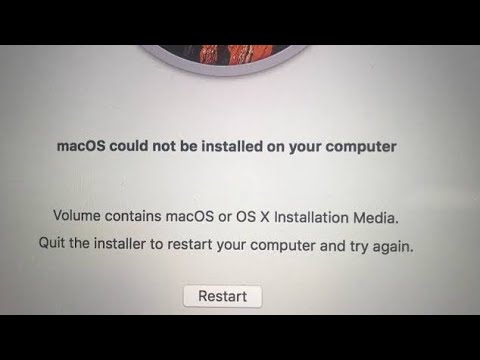
I have an older, MacBook Pro (15-inch, Mid 2009) that I intend to give as a gift.
The latest Mac OS you can run is 10.11 (El Capitan). Trying to install El Capitan but I keep getting a message no packages were eligible for install? #Macbook #MacOS #CoultNotBeInstalled1. Boot into MacOS Installer2. Open TerminaCatalina: Date Mojave: Date High Sierra: Date 092400001. The full operating system is a free download for anyone who has purchased Mac OS X Snow Leopard, Lion, or Mountain Lion or has a Mac preloaded with OS X Mavericks or Yosemite. Download the Application from the Mac App Store using your Apple ID on any Mac or functional computer running Mac OS X 10.6.8 or later. Open Mac App Store 2. Are you reinstalling Apple Mac OS X in your old laptop but getting error 'OS X could not be installed on your computer' and message appear 'No packages were.
For security reasons, I decided that I was a good to format the drive and reinstall OS X El Capitan.
My first effort was thwarted by an error:

This item is temporarily unavailable.Try again later.
Mac Os X No Packages Were Eligible For Install Disk
After reading Wiped drive, now can’t reinstall El Capitan from Recovery because the “item is temporarily unavailable”, I supplied a different set of icloud credentials, and the process continued.
Eventually, however, the installation failed with a different message:
No packages were eligible for install. Contact the software manufacturer for assistance. Quit the installed to restart your computer and try again.
I tried using 'Internet Recovery' (Option+Command+R) and a bootable USB drive that contained El Capitan, both of which ultimately failed with the same message.
Is there a way to get this to work?
To create a bootable USB drive, I needed the Install OS X El Capitan.app package.
Using my MBP 16', I used the Download OS X El Capitan link on Apple's support site to get the installer.
Unfortunately, running the InstallMacOSX.pkg package in the DMG failed:
This version of OS X 10.11 cannot be installed on this computer.
I 'found' a Install OS X El Capitan.app package and was able to create the bootable media.
When trying to upgrade from OS X 10.6.8 Snow Leopard to OS X 10.11.6 El Capitan, I repeatedly encountered a frustrating error message: 'OS X could not be installed on your computer. No packages were eligible for install. Contact the software manufacturer for assistance. Quit the installer to restart your computer and try again.'
My end goal was to install macOS 10.13 High Sierra. I read online that one must upgrade to OS X 10.11 before upgrading to macOS 10.13 if one is starting from OS X 10.6. This upgrade route did not work for me no matter how many solutions I attempted. I eventually found a solution to this frustrating problem which I'll share below, but before I do that, I'd like to share what did NOT work for me to hopefully help others avoid unnecessary frustration and wasted time:
Solution attempts that did NOT work for me:
I tried changing the time to the correct present time and to a past time when the installer certificates may have still been valid (mid-2016). The upgrade problem persisted either way.
Manually setting the date and time via the Terminal (see above link) to an earlier date is worth trying because it has worked for some people. Try this time: 1010101015

2) Erasing my internal hard drive using Disk Utility in Internet Recovery Mode
All this did was remove my data, but the persistent 'OS X could not be installed...' problem remained.
3) Booting from an external hard drive that was formatted to act as an installer for OS X 10.11
4) Booting in the Internet Recovery Mode option to install the version closest to the operating system that came with my Mac (Shift+Option+Command+R).
My Mac came with Snow Leopard, which is not available to download, so it attempted to install Lion, but wasn't able to do so because I had not purchased it with my Apple ID.
Here's the upgrade route that DID work for me:
1) I purchased OS X 10.7 Lion with my Apple ID and downloaded it via the Mac App Store on another Mac (so it would be in my App Store download history)

2) I booted in the Internet Recovery Mode option to install the version closest to the operating system that came with my Mac by holding down Shift+Option+Command+R while my MacBook was restarting.
3) I selected 'Reinstall Mac OS X' in the 'Mac OS X Utilities' window that appeared when Internet Recovery Mode fully booted up.
4) When prompted, I entered my Apple ID information that was used to purchase and download OS X 10.7 Lion and allowed the OS X upgrade to proceed to completion. I then had a fresh version of OS X 10.7 Lion installed on my Mac.
5) The next step was to upgrade from OS X 10.7 Lion to macOS 10.12 Sierra using these steps.
6) Once macOS 10.12 Sierra was fully installed, I upgraded to macOS 10.13 High Sierra using these steps.
My MacBook Pro is now successfully running macOS 10.13.6 High Sierra.
Mac Os X No Packages Were Eligible For Install Windows 7
Basically, what worked for me was circumnavigating the suggested route of installing OS X 10.11 before installing macOS 10.13. Instead, I followed this upgrade route: 10.6 to 10.7, then 10.12 to 10.13.
I thought it may be helpful to share what worked for me in case someone else out there is trying to upgrade from OS X 10.6 Snow Leopard to macOS 10.13 High Sierra and encountering the issue I encountered. Please feel free to ask me any questions about this and I will do my best to help.



